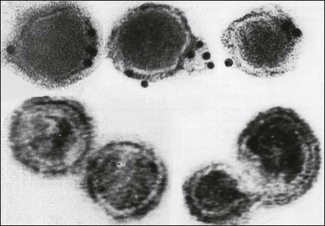Chapter 66 The family Bornaviridae belongs to the order Mononegavirales. There is a single genus, Bornavirus, with a single member species, Borna disease virus (BDV). However, proventicular dilatation disease of parrots has been linked to an avian bornavirus (Honkavuori et al. 2008). Borna disease virus, which has a nondescript appearance, is spherical and about 90 nm in diameter (Fig. 66.1). An envelope surrounds an inner, spherical core, 50 to 60 nm in diameter, which contains a single molecule of negative-sense, single-stranded RNA. Unusual among non-segmented, negative-sense RNA animal viruses, replication of BDV occurs in the nucleus of host cells with budding at the cell surface. The virus spreads by cell-to-cell contact without producing cytopathic effects. The virus is labile, being sensitive to heat, lipid solvents and acid pH. Figure 66.1 Negative stain electron micrograph with immunogold label for Borna disease virus. Reprinted with permission: Veterinary Virology Third Edition (1999). Murphy et al., Academic Press. Page 456. Borna disease was first described in southern Germany and owes its name to the town of Borna in Saxony where many horses died in an epidemic of the disease in 1885. It has primarily been associated with persistent infection and fatal neurological disease in horses and sheep. The disease occurs sporadically in Germany and Switzerland but sero-epidemiological studies suggest a much wider distribution. Antibodies reactive with BDV have been found in the sera of human patients with neuropsychiatric disorders and interest has focused on a possible link between the virus and human neurological disorders (Boucher et al. 1999). Natural infections have been described in horses, ruminants, rabbits, cats and ostriches. It is thought that virus is transmitted through saliva and nasal secretions with susceptible animals becoming infected by direct contact or through contaminated food or water. Most cases of Borna disease occur in spring and early summer with cases being more common in some years than others. Persistent infections can be established in rats and there is evidence that rodents may act as a reservoir host species (Hilbe et al. 2006, Puorger et al. 2010). The incubation period is highly variable from days to several months but is usually about four weeks. The virus is highly neurotropic and following infection by the oronasal route, gains entry to the CNS by migrating intra-axonally through the olfactory nerve or nerve endings in the oropharyngeal and intestinal regions. Viral spread throughout the CNS and centrifugally in peripheral nerves occurs by intra-axonal transport. Distribution of the virus in the brain suggests a preference for the limbic system, probably determined by the presence of certain neuro-receptors. Viral antigens on the surface of infected cells in the CNS elicit a cell-mediated immunopathological reaction involving cytotoxic CD8+ and CD4+ helper T lymphocytes and lysis of infected neurons. Antibody titres in infected animals are relatively low and are non-protective but are not involved in the pathogenesis of the disease. Clinical signs do not occur in immunocompromised animals despite the establishment of persistent infection. The disease course lasts one to three weeks with mortality rates of 37 to 94% in affected horses. Surviving horses have permanent CNS deficits and may undergo recurrent episodes. ‘Staggering disease’ in cats has been shown to be associated with BDV infection (Lundgren et al. 1995).
Bornaviridae

Borna disease
Pathogenesis
![]()
Stay updated, free articles. Join our Telegram channel

Full access? Get Clinical Tree


